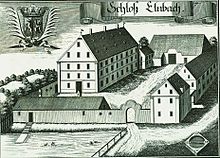Oberellenbach Castle
| Oberellenbach Castle | |
|---|---|
 Oberellenbach Castle |
|
| Data | |
| place | Oberellenbach 1, Mallersdorf-Pfaffenberg |
| Coordinates | 48 ° 44 '12.7 " N , 12 ° 15' 6.7" E |
The Oberellenbach Castle is located in the same district of the market Mallersdorf-Pfaffenberg in Lower Bavaria Straubing-Bogen district .
history
Around 1100 a Pero de Alinpach donated some censuals to the monastery of Sankt Emmeram . A Rodiger de Alinpah appears on June 11, 1177 as a witness in a monastery charter . After the first Duke Surbar (1229/1237) there was an office and a court seat in the place Ellenbach. In the second Duke's Surbar (1280) the office is called gerihtt ze Elnpach and the ducal estates are called Niederhof, Oberhof and Sölde; this seems to initiate a distinction between Ober- and Unterellenbach. At the time of the third Duke Surbar (1310), Ellenbach is still the seat of the court, the Unterhof and the Weilnberg fief are owned by the Sprittacher. The Sprittach can be followed in Ellenbach until 1421. Ezelhauser and Öder sit together on the Oberhof. In 1311 a Konrad, Klostermaier zu Ellenbach, and a Konrad, Maier des Mengkofers appear as witnesses in a document from the Mallersdorf monastery . In 1318 the duke redeemed the Unterhof again. In the same year Nikolaus Tömlinger sits on the Oberhof and describes it as a direct ducal fiefdom . In 1339 the Seligenthal monastery owned the Oberhof and the Weilnberg fief. Apparently the Mallersdorf monastery in Ellenbach owned the Unterhof around 1311, as a Maier of the monastery is attested there.
Towards the end of the 14th century, the documents already differentiated between Unter- and Oberellenbach. Konrad Hächtaler zu Niederellenbach compares himself on December 21, 1391 with the Sattelbogen and the Mallersdorf monastery. On December 3, 1395, Konrad Mengkofer and his wife sold their own farm in Niederellenbach to their cousin Hans Sigenhofer. The Sprittachers were at least temporarily owners of a noble farm in the village of Ellenbach.
A Hofmark seems to have been created here in the middle of the 14th century, because in the Kirchberg court documents a court of Ellenbach is mentioned in 1430. In 1447 this Hofmark exists in Oberellenbach. In 1458 a Martin Armannsperger sits on Ellenbach, in 1464 the Armannsperger gentlemen are on Niederbach and Oberellenbach. The Armannsperger zu Ellnbach appear in the country tables from 1470 to 1580 , which means the Hofmark Oberellenbach. The following are named: Armansperger zu Elnpach (1470), Georg Armannsperger zu Ellenbach (1490), Jörig Armansperger zu Ellnpach (1494), Bartholomäus Armansperger (1510–1526), heirs of Bartholomäus (1538), Eustachius, Erasmus and Hanns Wilhelm Armannsperger (1558 –1578), Hans Sigmund von Armannsberg (1580). The Armannsbergers did indeed have noblemen's freedom on the various farms in Ellenbach, but a union of the Hofmark Oberellenbach with the village of Unterellenbach only seems to have taken place under their successors, the Lords of Leoprechting. From 1588 to 1616 Elias von Leoprechting is mentioned in the country table. The lords of Leoprechting stayed at Ellenbach until 1629, the last being Waltburg von Leoprechting.
During the Thirty Years War the Swedes invaded the place in 1634. Between 1636 and 1644 Oberellenbach belonged to the Schrenk von Naging. In the description of the Hofmark from 1689, Christoff Ludwig Stöckl is named as the owner of the Hofmark. Oberellenbach bought this from Doctor Schott'schen on the Gant . The Stöckel heirs are still in Oberellenbach in 1726. In 1752 the Hofmark belonged to Baron von Wagner. 1780–1796 the Lerchenfeld are named as Hofmark owners. In 1796 the Countess von Lerchenfeld sold the Hofmark to the pastor Max Koch von Leutzenkirchen; this remains in the possession of Oberellenbach until secularization . Oberellenbach was already a patrimonial court in 1806 . Then it came into the possession of the initially non-aristocratic farmer and brewer Johann Raymayr (supposedly since 1796). On September 24, 1813, he asked for confirmation from the local court and on January 1, 1820 Oberellenbach was confirmed as a patrimonial court. On September 29, 1824, the district judge Hilger zu Landau acquired the Oberellenbach estate by marrying Franziska von Raymayr, but this handover only took place after the nobility was acquired on June 23, 1825. On February 10, 1840, the judge widow Maria von Hilger married Max Ritter von Kobell and brought Oberellenbach into the marriage. From this, Prince von Thurn und Taxis acquired Oberellenbach on December 22, 1840 and incorporated it into his Neufahrn patrimonial court . The extradition from Oberellenbach then took place in 1848.

Ellenbach Castle then and now
As the engraving by Michael Wening from 1721 shows, Ellenbach Castle was a simple three-story building surrounded by several farm buildings, which together with a small wall formed a closed courtyard area. The castle stood next to a pond. In 1756 the castle was rebuilt and got a brewery and courtyard building. An associated summer cellar of the brewery was located southeast of the castle.
Today the castle is a simple three-storey gable roof with plaster band structure and three arched elevator openings. The supporting pillars on the narrow side of the building are striking. The rectangular building, directed from south to north, was probably built at the beginning of the 18th century. The castle is now privately inhabited.
literature
- Günther Pölsterl: Mallersdorf. The Kirchberg regional court, the Eggmühl and Abbach nursing courts. (= Historical Atlas of Bavaria, part of Altbayern issue 53), pp. 217–221. Commission for Bavarian History, Verlag Michael Lassleben, Munich 1979, ISBN 3-7696-9923-8 .
Web links
- Entry on Oberellenbach (castle) in the private database "Alle Burgen".
- Oberellenbach , district side near Markt Mallersdorf-Pfaffenberg
- Oberellenbach (Mallersdorf-Pfaffenberg) on regiowiki

